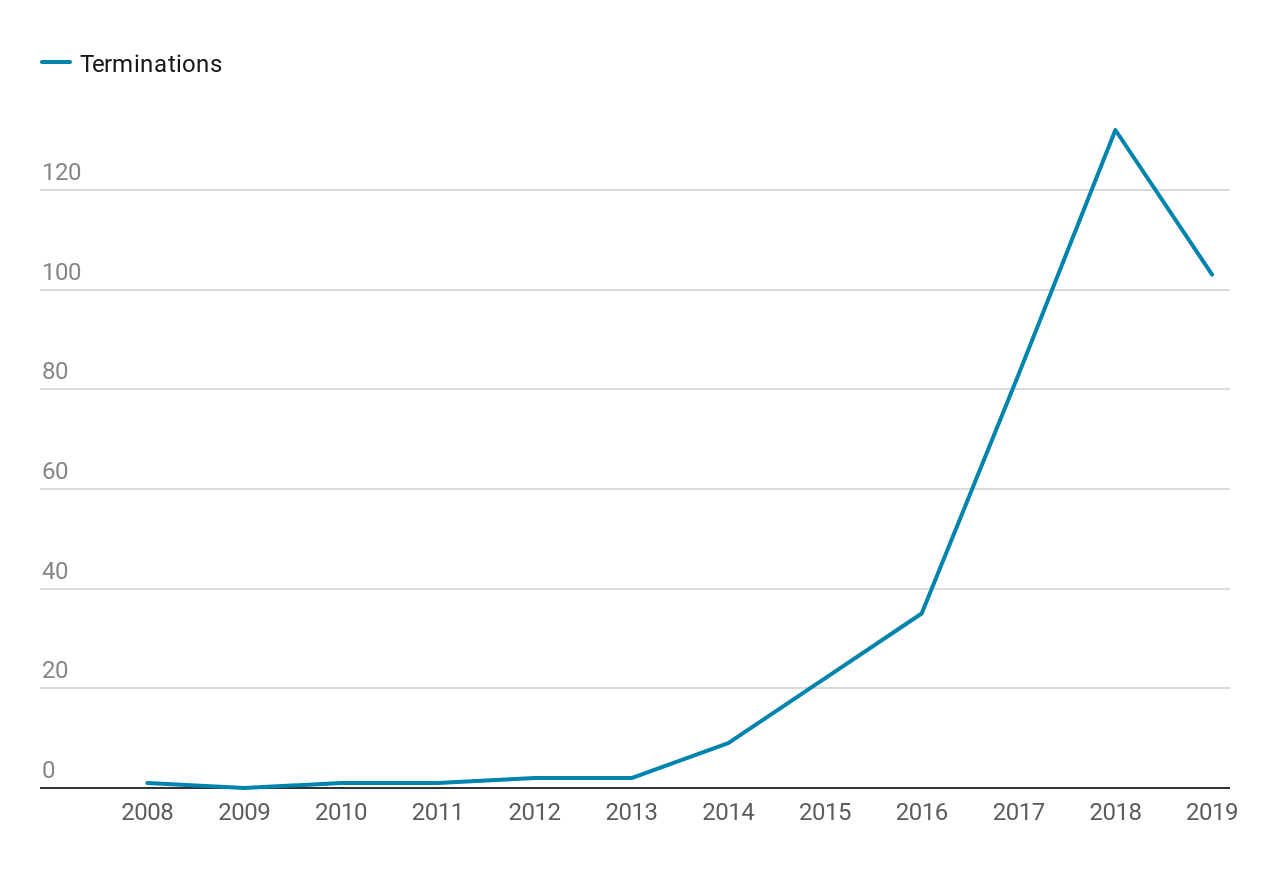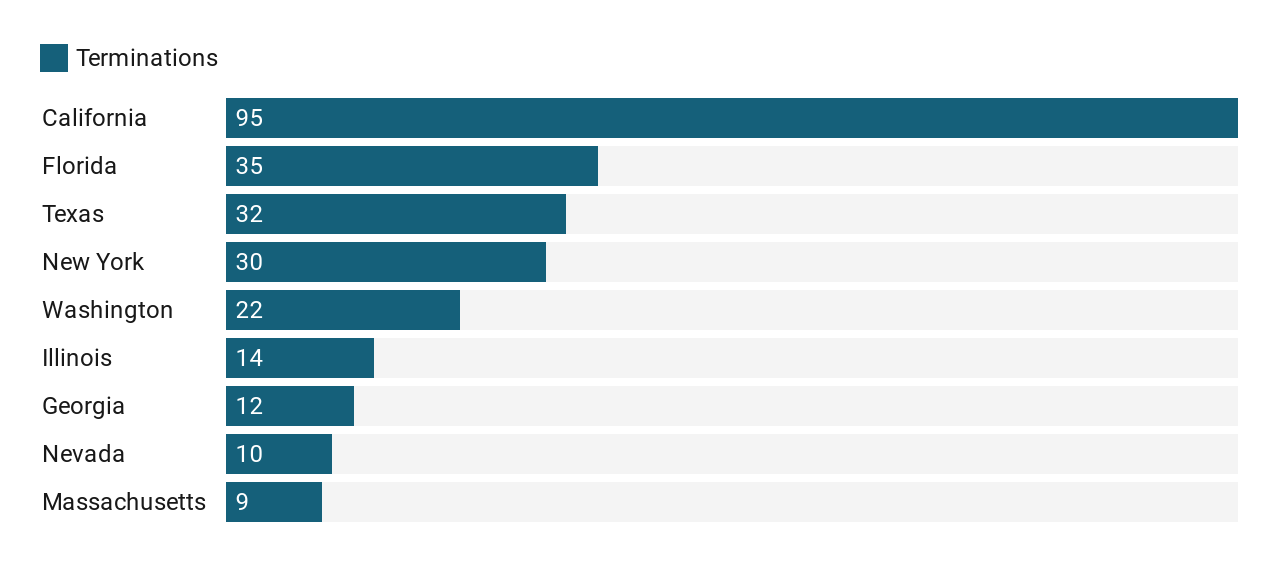A Regional center is a public/private economic unit, in the United States involved with promoting economic growth for the purpose for Employment based fifth preference (EB-5) program.
The 1993 Appropriations Act amended the EB-5 program to create the Immigrant Investor Pilot Program (IIPP) which allowed foreign nationals to invest in an economic unit called a Regional center (RC).
The main purpose of Regional Centers (RC) is to stimulate economic growth in a specified geographic area through the EB-5 immigrant investor program. Regional centers have jurisdiction over a limited geographic area
Regional centers reduce the immigrant investor’s responsibility to identify acceptable investment vehicles for the purpose of EB-5 allowing investors to pool their investments into a larger project assembled by a regional center.
How many regional centers are there?
We did a frequency analysis on the approvals and terminations of Regional centers using the data from USCIS page nominated for the purpose of the EB-5 program. The numerical. results we found are below.
As of Feb 3, 2020, there are 1,212 entries approved regional centers and 397 terminated regional center in the USCIS database. Regional centers can operate in more than one state.
This number is subjected to change from time to time..
Top 10 States with Regional Centers

Source: USCIS – Status as of Feb 3, 2020
| State | Total |
| California | 195 |
| New York | 105 |
| New Jersey | 82 |
| Florida | 73 |
| Texas | 69 |
| Pennsylvania | 67 |
| Washington | 61 |
| Connecticut | 52 |
| Georgia | 31 |
| Nevada | 31 |
| Illinois | 28 |
| Maryland | 24 |
| Oregon | 22 |
| Virginia | 22 |
| District of Columbia | 20 |
| North Carolina | 20 |
| Hawaii | 18 |
| Indiana | 18 |
| South Carolina | 18 |
| Wisconsin | 17 |
| Louisiana | 16 |
| Massachusetts | 16 |
| Ohio | 16 |
| Tennessee | 15 |
| Alabama | 13 |
| Colorado | 13 |
| Mississippi | 13 |
| Arizona | 12 |
| Delaware | 9 |
| Kentucky | 9 |
| New Hampshire | 9 |
| Rhode Island | 9 |
| New Mexico | 8 |
| Utah | 8 |
| West Virginia | 8 |
| Missouri | 7 |
| Oklahoma | 7 |
| Michigan | 6 |
| Kansas | 5 |
| Nebraska | 5 |
| Puerto Rico | 5 |
| Minnesota | 4 |
| Montana | 4 |
| Commonwealth of Northern Marianas Islands | 3 |
| Idaho | 3 |
| Iowa | 3 |
| Arkansas | 2 |
| Guam | 2 |
| Vermont | 2 |
| Wyoming | 2 |
| Alaska | 1 |
| Maine | 1 |
| North Dakota | 1 |
| U.S. Virgin Islands (USVI) | 1 |
Regional Center Terminations
The increase in Regional center terminations indicate an increase in non-compliance in Regional centers.
Data indicates the terminations took a steep rise after 2016 before reaching its peak in 2018..
USCIS may terminate a regional center if a RC
- Fails to submit required information to USCIS; or
- No longer serves the purpose of promoting economic growth.
As of Feb 3, 2020 there are 397 regional centers with terminations and some are pending.

A terminated RC may not solicit, generate, or promote investors or investments or otherwise participate as a designated regional center in connection with the Immigrant Investor Program
| Year | Terminations |
| 2008 | 1 |
| 2009 | 0 |
| 2010 | 1 |
| 2011 | 1 |
| 2012 | 2 |
| 2013 | 2 |
| 2014 | 9 |
| 2015 | 22 |
| 2016 | 35 |
| 2017 | 83 |
| 2018 | 132 |
| 2019 | 103 |
Source: USCIS / As of Feb 3, 2020
Terminations by State
As you can see, California has highest number of regional center terminations.

| Alabama | 3 |
| Alaska | 1 |
| Arizona | 8 |
| Arkansas | 4 |
| California | 95 |
| Colorado | 7 |
| Commonwealth of Northern Marianas Islands | 4 |
| Connecticut | 1 |
| District of Columbia | 5 |
| Florida | 35 |
| Georgia | 12 |
| Guam | 2 |
| Hawaii | 4 |
| Idaho | 2 |
| Illinois | 14 |
| Indiana | 7 |
| Iowa | 1 |
| Island of Guam | 1 |
| Kansas | 3 |
| Kentucky | 2 |
| Louisiana | 5 |
| Maine | 2 |
| Maryland | 3 |
| Massachusetts | 9 |
| Michigan | 8 |
| Minnesota | 2 |
| Mississippi | 3 |
| Missouri | 1 |
| Montana | 3 |
| Nebraska | 1 |
| Nevada | 10 |
| New Jersey | 7 |
| New Mexico | 2 |
| New York | 30 |
| North Carolina | 3 |
| North Dakota | 2 |
| Ohio | 5 |
| Oklahoma | 4 |
| Oregon | 2 |
| Pennsylvania | 7 |
| Puerto Rico | 4 |
| South Carolina | 4 |
| South Dakota | 1 |
| Tennessee | 2 |
| Texas | 32 |
| U.S. Virgin Islands (USVI) | 2 |
| Utah | 1 |
| Vermont | 1 |
| Virginia | 3 |
| Washington | 22 |
| West Virginia | 2 |
| Wisconsin | 2 |
| Wyoming | 1 |
| Total Result | 397 |
Source: USCIS / As of Feb 3, 2020
How to become a Regional Center?
A regional center can be associated with one or more new commercial enterprises.
A Regional center must present a proposal for the promotion of economic growth, including increased export sales, improved regional productivity, job creation, or increased domestic capital investment according to the following criteria
- Clearly describe how the regional center focuses on a geographical region of the United States and how it will promote economic growth through increased export sales, improved regional productivity, job creation, and increased domestic capital investment;
- Provide in verifiable detail how jobs will be created directly or indirectly;
- Provide a detailed statement regarding the amounts and sources of capital which have been already committed to the regional center;
- Provide a description of the promotional efforts taken and planned by the sponsors of the regional center;
- Include a detailed prediction how the regional center will have a positive impact on the regional or national economy based on factors such as increased household earnings, greater demand for business services, utilities, maintenance and repair, and construction both within and without the regional center; and
- Be supported by economically or statistically valid forecasting tools, including, but not limited to, feasibility studies, analyses of foreign and domestic markets for the goods or services to be exported, or multiplier tables.
A regional center seeking to participate in the Regional Center Program must submit a proposal using the Application For Regional Center Under the Immigrant Investor Program (Form I-924).
All regionals center must do annual reporting between October 1 and December 29 to renew their license for eligibility





